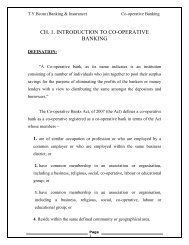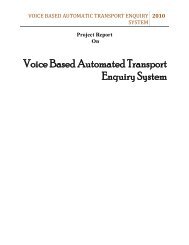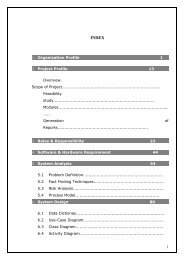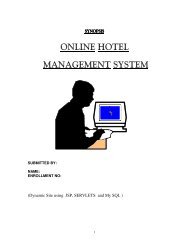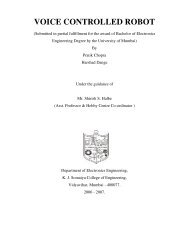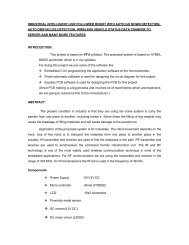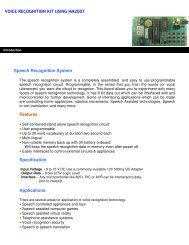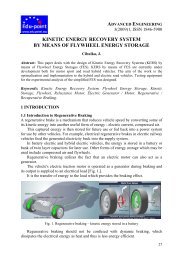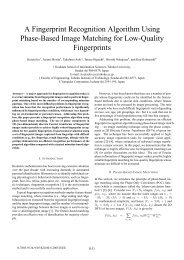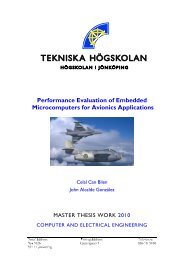Cloud Computing â âWhats the Buzz? - Ask, Find, Discuss about ...
Cloud Computing â âWhats the Buzz? - Ask, Find, Discuss about ...
Cloud Computing â âWhats the Buzz? - Ask, Find, Discuss about ...
- No tags were found...
You also want an ePaper? Increase the reach of your titles
YUMPU automatically turns print PDFs into web optimized ePapers that Google loves.
[ THE GOLDEN CLOUD ]“From CapEx to OpEx”Parul Saxena<strong>Cloud</strong> <strong>Computing</strong> transforms <strong>the</strong> financialparadigm of an enterprise. <strong>Cloud</strong> <strong>Computing</strong>shifts <strong>the</strong> CAPEX (Capital Expenditure) to anOPEX (Operating expenditure) model by useof operational expenses ra<strong>the</strong>r than capitalassets and <strong>the</strong> treatment of operatingstatements ra<strong>the</strong>r than balance sheetmanagement.Adopting <strong>the</strong> <strong>Cloud</strong> <strong>Computing</strong> paradigmseeks to make more money (increaserevenues) while driving capital costs downthrough greater efficiencies of workingcapital and OPEX changes. As per IBM's CTOfor <strong>Cloud</strong> <strong>Computing</strong>, Kristof Kloeckner, cloudcomputing reduces IT labor costs by up to50%, improves capital utilization by 75% andreduces provisioning from weeks to minutes.However what is <strong>the</strong> primary motivation ofany firm’s financial resource? It is costreduction.How does cloud computing efficientlyachieve cost reduction?An article written by Michael Amburst, ”TheView of <strong>Cloud</strong> <strong>Computing</strong>” answers thisquestion through <strong>the</strong> following three cases:Case One‐ Demand for a service varies withtime. If a conventional data center isprovisioned for its peak <strong>the</strong>n it would beunderutilized on o<strong>the</strong>r days. Instead, cloudcomputing lets an organization pay by <strong>the</strong>hour for computing resources, potentiallyleading to cost savings, even if <strong>the</strong> hourly rateto rent a machine from a cloud provider ishigher than <strong>the</strong> rate to own one. As per <strong>the</strong>example taken by Michael Amburst, if anenterprise’ service has a predictable demandwhere at peak <strong>the</strong> requirement is 500 serverswhile at trough only 100 are required and <strong>the</strong>average utilization over a whole day is 300servers, <strong>the</strong> actual cost per day is 300 × 24 =7,200 server hours; but since it must beprovisioned for <strong>the</strong> peak of 500 servers, wepay for 500 ×24 = 12,000 server‐hours, afactor of 1.7 more. Therefore, as long as <strong>the</strong>“pay‐as‐you‐go cost” per server‐hour overthree years (usual amortization time) is lessthan 1.7 times <strong>the</strong> cost of buying <strong>the</strong> server,utility computing is cheaper thanconventional data centers.Case Two‐ Forecasting of unknown demand.For example a startup meets invariabledemand. Initially <strong>the</strong>re might be a highdemand but it might gradually wean away. Asecond scenario could be unforeseendemand. To understand that by taking ahypo<strong>the</strong>tical example, we can divide <strong>the</strong>users in two categories: active users anddefectors (those who abandon <strong>the</strong> site or areturned away from <strong>the</strong> site due to poorperformance).Assuming that 10% of users are lostpermanently due to under‐provisioning inpeak hours.If we have 400 servers with each havingcapacity of 1000 users, total capacity that canbe handled is 400000 users .But with duepopularity if it has 500000 hits in 1st hour<strong>the</strong>n as per our assumption 10000 users arelost (permanently) with 4,90,000 users left.If in next hour, we have 2,50,000 new andunique users <strong>the</strong>n as 10,000 can still beaccommodated rest 2,40,000 are23



